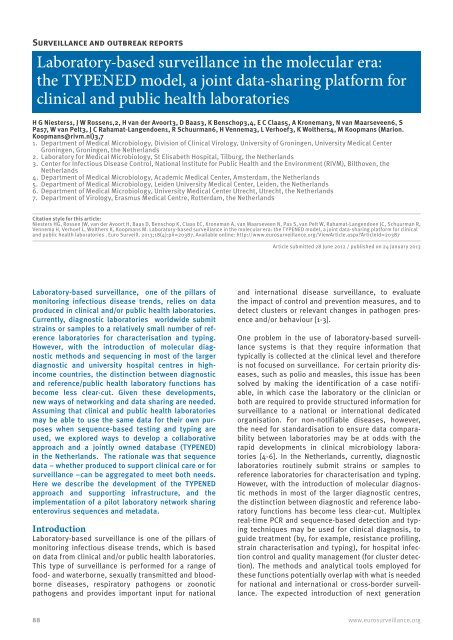Neisseria meningitidis - Eurosurveillance
Neisseria meningitidis - Eurosurveillance
Neisseria meningitidis - Eurosurveillance
You also want an ePaper? Increase the reach of your titles
YUMPU automatically turns print PDFs into web optimized ePapers that Google loves.
Surveillance and outbreak reports<br />
Laboratory-based surveillance in the molecular era:<br />
the TYPENED model, a joint data-sharing platform for<br />
clinical and public health laboratories<br />
H G Niesters1, J W Rossen1,2, H van der Avoort3, D Baas3, K Benschop3,4, E C Claas5, A Kroneman3, N van Maarseveen6, S<br />
Pas7, W van Pelt3, J C Rahamat-Langendoen1, R Schuurman6, H Vennema3, L Verhoef3, K Wolthers4, M Koopmans (Marion.<br />
Koopmans@rivm.nl)3,7<br />
1. Department of Medical Microbiology, Division of Clinical Virology, University of Groningen, University Medical Center<br />
Groningen, Groningen, the Netherlands<br />
2. Laboratory for Medical Microbiology, St Elisabeth Hospital, Tilburg, the Netherlands<br />
3. Center for Infectious Disease Control, National Institute for Public Health and the Environment (RIVM), Bilthoven, the<br />
Netherlands<br />
4. Department of Medical Microbiology, Academic Medical Center, Amsterdam, the Netherlands<br />
5. Department of Medical Microbiology, Leiden University Medical Center, Leiden, the Netherlands<br />
6. Department of Medical Microbiology, University Medical Center Utrecht, Utrecht, the Netherlands<br />
7. Department of Virology, Erasmus Medical Centre, Rotterdam, the Netherlands<br />
Citation style for this article:<br />
Niesters HG, Rossen JW, van der Avoort H, Baas D, Benschop K, Claas EC, Kroneman A, van Maarseveen N, Pas S, van Pelt W, Rahamat-Langendoen JC, Schuurman R,<br />
Vennema H, Verhoef L, Wolthers K, Koopmans M. Laboratory-based surveillance in the molecular era: the TYPENED model, a joint data-sharing platform for clinical<br />
and public health laboratories . Euro Surveill. 2013;18(4):pii=20387. Available online: http://www.eurosurveillance.org/ViewArticle.aspx?ArticleId=20387<br />
Laboratory-based surveillance, one of the pillars of<br />
monitoring infectious disease trends, relies on data<br />
produced in clinical and/or public health laboratories.<br />
Currently, diagnostic laboratories worldwide submit<br />
strains or samples to a relatively small number of reference<br />
laboratories for characterisation and typing.<br />
However, with the introduction of molecular diagnostic<br />
methods and sequencing in most of the larger<br />
diagnostic and university hospital centres in highincome<br />
countries, the distinction between diagnostic<br />
and reference/public health laboratory functions has<br />
become less clear-cut. Given these developments,<br />
new ways of networking and data sharing are needed.<br />
Assuming that clinical and public health laboratories<br />
may be able to use the same data for their own purposes<br />
when sequence-based testing and typing are<br />
used, we explored ways to develop a collaborative<br />
approach and a jointly owned database (TYPENED)<br />
in the Netherlands. The rationale was that sequence<br />
data – whether produced to support clinical care or for<br />
surveillance –can be aggregated to meet both needs.<br />
Here we describe the development of the TYPENED<br />
approach and supporting infrastructure, and the<br />
implementation of a pilot laboratory network sharing<br />
enterovirus sequences and metadata.<br />
Introduction<br />
Laboratory-based surveillance is one of the pillars of<br />
monitoring infectious disease trends, which is based<br />
on data from clinical and/or public health laboratories.<br />
This type of surveillance is performed for a range of<br />
food- and waterborne, sexually transmitted and bloodborne<br />
diseases, respiratory pathogens or zoonotic<br />
pathogens and provides important input for national<br />
Article submitted 28 June 2012 / published on 24 January 2013<br />
and international disease surveillance, to evaluate<br />
the impact of control and prevention measures, and to<br />
detect clusters or relevant changes in pathogen presence<br />
and/or behaviour [1-3].<br />
One problem in the use of laboratory-based surveillance<br />
systems is that they require information that<br />
typically is collected at the clinical level and therefore<br />
is not focused on surveillance. For certain priority diseases,<br />
such as polio and measles, this issue has been<br />
solved by making the identification of a case notifiable,<br />
in which case the laboratory or the clinician or<br />
both are required to provide structured information for<br />
surveillance to a national or international dedicated<br />
organisation. For non-notifiable diseases, however,<br />
the need for standardisation to ensure data comparability<br />
between laboratories may be at odds with the<br />
rapid developments in clinical microbiology laboratories<br />
[4-6]. In the Netherlands, currently, diagnostic<br />
laboratories routinely submit strains or samples to<br />
reference laboratories for characterisation and typing.<br />
However, with the introduction of molecular diagnostic<br />
methods in most of the larger diagnostic centres,<br />
the distinction between diagnostic and reference laboratory<br />
functions has become less clear-cut. Multiplex<br />
real-time PCR and sequence-based detection and typing<br />
techniques may be used for clinical diagnosis, to<br />
guide treatment (by, for example, resistance profiling,<br />
strain characterisation and typing), for hospital infection<br />
control and quality management (for cluster detection).<br />
The methods and analytical tools employed for<br />
these functions potentially overlap with what is needed<br />
for national and international or cross-border surveillance.<br />
The expected introduction of next generation<br />
88 www.eurosurveillance.org
















